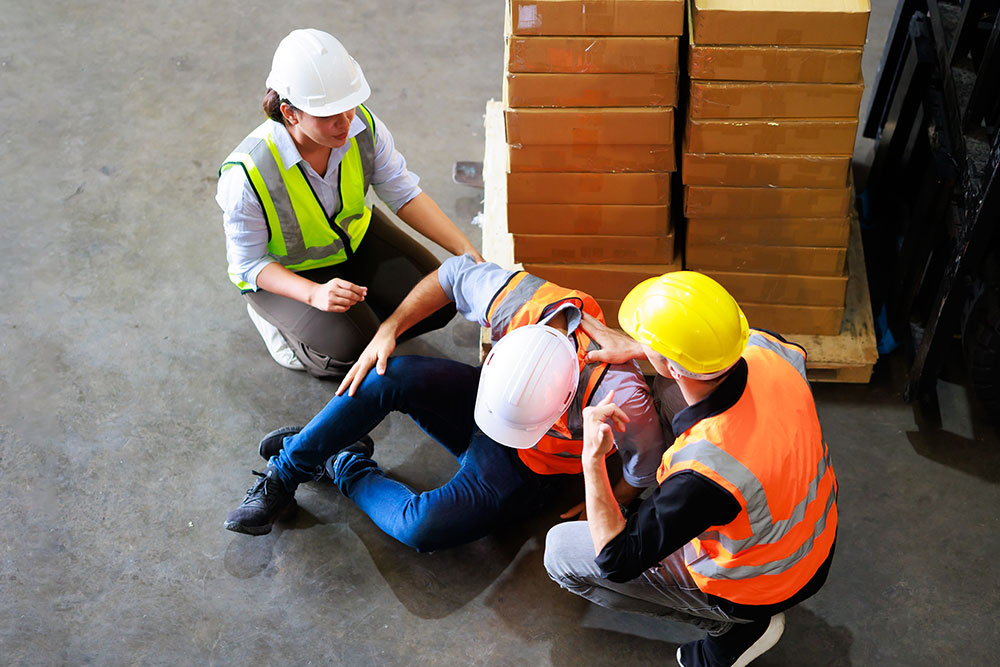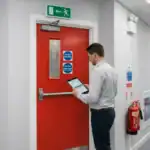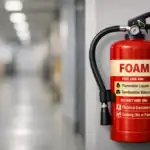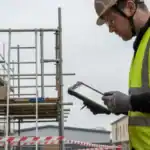
“What should I do after an accident in the workplace?” is a common question. Accidents are rare, so most people are unfamiliar with how to handle them.
But what you do after an incident can help ensure it’s a one-off and prevent legal issues later on.
This guide explains what to do immediately after an incident and in the days that follow. It covers emergency responses and duties to record and report accidents to the relevant authorities.
What Should I Do After an Accident in the Workplace? – Key Takeaways
- Immediately after an accident, assess the situation for any lingering dangers before assisting.
- Follow the DRABC steps (Danger, Response, Airway, Breathing, Circulation) to assess the casualty’s condition.
- Check your workplace has an up-to-date first aid needs assessment and adequate first aid provisions.
- Accidents must be recorded if your organisation employs more than ten people.
- Serious accidents must be reported to the Health and Safety Executive (HSE) as required by law.
Accident Investigation Training
Our accident investigation training guides users through a step-by-step process for investigating workplace accidents. It helps trainees gather facts, identify root causes, interpret findings and implement measures to prevent future incidents.
What Should I Do Immediately?
The first answer to “What should I do after an accident in the workplace?” is to help the casualty.
But before you can offer any assistance, it’s critical to assess the situation. People who rush in before the danger has passed might end up as another casualty. So, look for any lingering risks to yourself or anyone else present.
This is the first step of a primary survey – an assessment of the situation that helps first responders identify and treat any immediate threats to life. Each step is summarised in the acronym DRABC:
- Danger
- Response
- Airway
- Breathing
- Circulation
We’ve written about DRABC in more detail before, but in short, you should:
- Ensure there’s no remaining danger to yourself or others present
- Speak to the casualty to test if they’re responsive
- Check the casualty’s airway is clear
- Check if the casualty is breathing
- Check for signs of bleeding (loss of circulation)
If the casualty is unresponsive or seriously injured, call 999. Keep the line open and stay with the casualty. Cardiopulmonary resuscitation (CPR) or using a defibrillator might be necessary.
If you’ve never been shown how to perform CPR or operate a defibrillator, don’t be intimidated. The emergency dispatcher can help talk you through the procedure, and defibrillators are designed to be foolproof.
If signs are good after the primary survey, you might be able to go on and conduct a secondary survey.

Secondary Survey
Secondary surveys are the first stage of information gathering. If the casualty is responsive, you should ask them what happened and how they were injured.
This information will be helpful for trained first aiders and emergency services. It will also be useful later when investigating the accident and how it can be prevented from happening again, but focus on helping the casualty first.
First Aid
If the casualty is stable, you should retrieve your workplace’s first aid kit along with anyone trained to use it.
You might not have any trained first aiders among your colleagues if your workplace is particularly small. First aid provisions, including the number of trained first aiders, are determined by a first aid needs assessment.
At a minimum, every workplace needs a well-stocked first aid kit and someone responsible for it. But smaller, low-risk workplaces won’t necessarily need someone trained to administer emergency first aid.
An accident could be a good prompt to check your first aid needs assessment. If you struggled to locate a first aid kit or someone trained to help, you might need to rethink your provisions.
What Needs to be Recorded?
After casualties are safe and there’s no further risk of injury, it’s time to record the accident.
How you do this depends on what happened and the size of your organisation.
If You Have 10 or More Employees
If you have more than ten employees, you must have a formal accident book. This requirement comes from the Social Security (Claims and Payments) Regulations 1979.
Under these regulations, employers must record all workplace accidents in case they result in a social security claim. If this happens, accident records are valuable evidence in deciding entitlements.
Small Businesses
You aren’t legally required to maintain an accident book if fewer than ten people are employed at your workplace.
But it’s still strongly recommended you record accidents for two reasons.
First, it can help with other post-incident duties (we’ll come back to this later).
Second, accidents should be investigated so the root causes can be found and fixed.
Who Needs to be Informed?
Employers must be made aware of any workplace accident. They’re responsible for the health and safety of everyone on their premises, so they need to be informed when anyone’s hurt. If an accident has happened, it’s possible that something isn’t up to standard or compliant with regulations.
Employers are also expected to report incidents to the Health and Safety Executive (or local authority) in specific circumstances under the Reporting of Injuries, Diseases and Dangerous Occurrences Regulations 2013
The Reporting of Injuries, Diseases and Dangerous Occurrences Regulations
The Reporting of Injuries, Diseases and Dangerous Occurrences Regulations (RIDDOR) require certain workplace incidents to be reported to the relevant authority, which is typically the Health and Safety Executive (HSE).
Not every accident is reportable under RIDDOR. The regulations specify what incidents must be reported, but it’s generally any work-related accident where someone was seriously hurt or came close to being seriously hurt. In short, you must report:
- Fatalities
- Severe injuries (these are specified in the regulations)
- Injuries that incapacitate workers for seven days or more
- Occupational diseases (these are specified in the regulations)
- Dangerous occurrences (near misses – these are also specified in the regulations)
How and When Do I Have to Report?
Under RIDDOR, injury reports should be made via the “quickest practicable means”.
The HSE encourages online reporting for most incidents, as this can be done at any time. Fatalities and severe injuries can be reported over the phone, but lines aren’t open outside of normal working hours.
Although accident reports should be a priority, you do have some time:
- You have 10 days to report a fatality or specified injury
- You have 15 days to report an incident that causes an incapacitation
Health and Safety Training
If you’ve ever asked, “What should I do after an accident in the workplace?” you may need some pointers. Health and safety training can prepare you and your team to respond effectively to accidents and ensure legal compliance.
Explore our Health and Safety Courses to learn more about how you can equip yourself with the skills needed to handle workplace accidents and prevent them from happening in the first place.





















